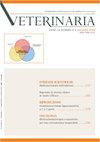Análisis del perfil de susceptibilidad de la garrapata Rhipicephalus microplus para cinco grupos químicos y factores asociados en poblaciones de campo del norte de Uruguay
Q4 Veterinary
引用次数: 0
Abstract
espanolEn Uruguay la problematica de la resistencia de Rhipicephalus microplus a los acaricidas habilitados ha ido incrementando con los anos, agravandose con la aparicion de poblaciones multirre-sistentes en 2009. El objetivo del trabajo fue analizar la resisten-cia de 47 poblaciones de garrapatas entre los anos 2017 y 2018 para cinco grupos quimicos: piretroides (cipermetrina, flumetri-na), organofosforados (ethion), amidinas (amitraz), fenilpirazo-les (fipronil) y lactonas macrociclicas (ivermectina), utilizando el Test de Paquete de Larvas (TLP) y una encuesta que se reali-zaba al responsable del establecimiento. De las 47 poblaciones analizadas 46 fueron resistentes a piretroides (46 cipermetrina, 45 flumetrina), presentando en su mayoria un alto nivel de resis-tencia. Todas las poblaciones muestreadas presentaron resisten-cia al menos a un grupo quimico. El 68,1 % a tres o mas grupos quimicos de forma simultanea pero ninguna presento resistencia ni susceptibilidad a los cinco analizados. Hubo poblaciones que presentaron resistencia a algunos grupos quimicos que no ha-bian sido utilizados en los establecimientos de los que fueron muestreadas. La mayoria de los predios realizaron un numero mayor de tratamientos al ano que el recomendado para un trata-miento generacional. Para todos los principios activos evaluados hubo poblaciones con sospechas de resistencia que no se confir-maron mediante TPL. Esto refleja las situaciones complejas que presentan hoy estos establecimientos en torno a la resistencia a los acaricidas por parte de R. microplus, que podria estar vin-culada al modo, frecuencia y tiempo de uso de estos acaricidas. Asi como tambien a su uso pero con otros fines y a los mo-vimientos, ingresos principalmente, de animales a los predios EnglishAcaricide resistance of Rhipicephalus microplus tick in Uruguay means a serious problem that has been worsening through years hitting a high point with the detection of multiresistant popula-tions on 2009. Therefore, the aim of this study was to analyze resistance for five chemical groups: pyrethroids (cypermethrin, flumethrin), organophosphates (ethion), amidines (amitraz), phenylpyrazoles (fipronil), macrocyclic lactones (ivermectin) on 47 populations between years 2017 and 2018 by using the Larval Packet Test (LPT) and a quiz made to the responsible for the farm. Results show that 46 from the 47 populations analyzed were resistant to pyrethroids (46 to cypermethrina, 45 to flume-thryn). This chemical group also showed the largest number of resistant populations with a high grade of resistance. Every pop-ulation showed to be resistant to at least one chemical group fur-thermore the 68.1 % of the populations were resistant to at least 3 chemical groups simultaneously but no population was diag-nosed resistant to the 5 chemical groups analyzed neither to be susceptible to all 5 chemical groups. It stands out that there were populations resistant to some chemical groups that the farms of origin had never used. There were registered a higher number of treatments done per year to control R. microplus, than the one recommended for a generational treatment. For every active ingredient evaluated, there were suspicions of resistance that the Larval Packet Test could not confirm. This reflects the complex situation of these farms in what refers to acaricide resistance of R. microplus. This may be related to the way, frequency and time acaricides had been used on these farms, as well as using them for other purposes and also due to the impact of the in-come of animals infested with R. microplus from other origins.乌拉圭北部野外人群中微头滴虫对五种化学群及相关因素的敏感性分析
在乌拉圭,微头滴虫对杀螨剂的耐药性问题多年来一直在增加,2009年出现了多种群。工作的目标是分析蜱虫种群resisten-cia 47年2017年和2018年五个团体之间化学物质:除虫菊酯(氰戊菊酯、flumetri-na (ethion有机磷)、amidinas(甲)fenilpirazo-les(氟虫腈和lactonas macrociclicas(伊维菌素),使用测试包幼虫(月内)和一项民调reali-zaba负责建立。在本研究中,我们分析了对拟除虫菊酯(46种氯氰菊酯,45种氟氰菊酯)的抗性,其中大多数具有较高的抗性水平。在本研究中,我们分析了两种不同的化学基团,一种是抗氧化基团,另一种是抗氧化基团。68.1%同时对三种或三种以上化学组,但对所有五种化学组均无耐药性或易感性。对某些化学群表现出耐药性的人群在抽样的设施中没有使用过。大多数农场每年进行的处理次数超过了推荐的世代处理次数。对于所有被评估的活性成分,都有未被TPL证实的怀疑耐药人群。这反映了这些机构目前关于微加鼠对杀螨剂的抗性的复杂情况,这可能与使用这些杀螨剂的方式、频率和时间有关。就是太但其他目的和用途mo-vimientos,主要的收入、动物训练场EnglishAcaricide resistance of Rhipicephalus microplus滴答in乌拉圭means严重problem that has been worsening through》" (a high point with the检测of multiresistant popula-tions on 2009年。因此,the aim of this study was to analyze resistance for five化学:pyrethroids (cypermethrin群组,flumethrin organophosphates (ethion)、amidines(甲)phenylpyrazoles(氟虫腈)、macrocyclic lactones (ivermectin) on 47人口between 2017年和2018年by using the Test(官阶幼虫Packet) and a quiz made to the responsible for the农场。结果显示,47个分析群体中有46个对除虫菊酯有耐药性(46个对氯菊酯有耐药性,45个对氟菊酯有耐药性)。该化学组还显示了数量最多的耐药种群,具有很高的耐药程度。每个pop-ulation显示对至少一个化学组具有抗性,但68.1%的人口同时对至少3个化学组具有抗性,但没有一个人口被诊断对所有5个化学组具有抗性。它表明,有一些种群对某些化学群具有抗性,而这些化学群的起源农场从未使用过。据记录,每年为控制R. microplus而进行的治疗次数比建议的代际治疗次数要多。对于所评估的每一种活性成分,都有耐药性的怀疑,幼虫包试验无法证实。这反映了这些农场在微鼠杀螨抗性方面的复杂情况。这可能与这些农场使用杀螨剂的方式、频率和时间有关,也可能与将杀螨剂用于其他目的有关,也可能与从其他来源感染小鼠的动物进入的影响有关。
本文章由计算机程序翻译,如有差异,请以英文原文为准。
求助全文
约1分钟内获得全文
求助全文
来源期刊

Veterinaria
农林科学-兽医学
CiteScore
0.10
自引率
0.00%
发文量
21
审稿时长
>12 weeks
期刊介绍:
VETERINARIA is the official scientific journal of the Italian Companion Animal Veterinary Association (SCIVAC) and is published bimonthly by Edizioni Veterinarie (E.V.). Its aim is to promote the spread and development of new ideas and techniques in the field of clinical and veterinary practices, with the ultimate goal of improving and promoting the continuing education of veterinary practicioners. VETERINARIA publishes literature reviews, original articles, diagnostic corners and clinical cases on different topics related to medicine and surgery of the dog, cat and of other companion animals, as well as short communications from congresses.
 求助内容:
求助内容: 应助结果提醒方式:
应助结果提醒方式:


